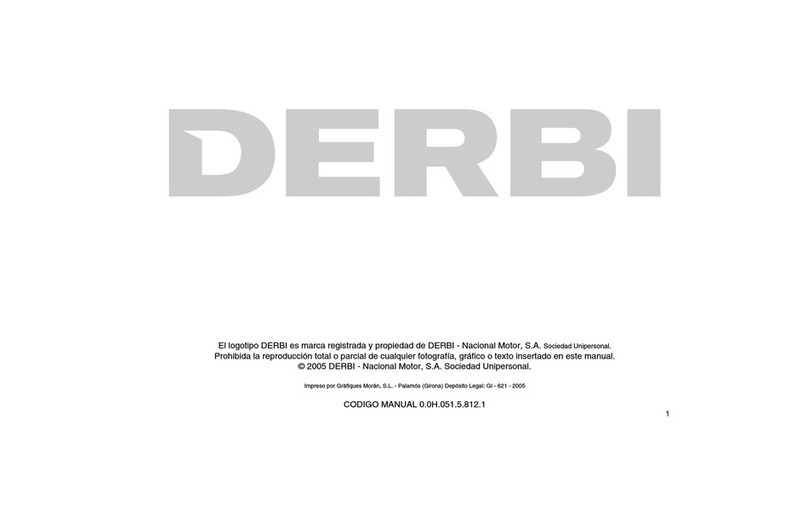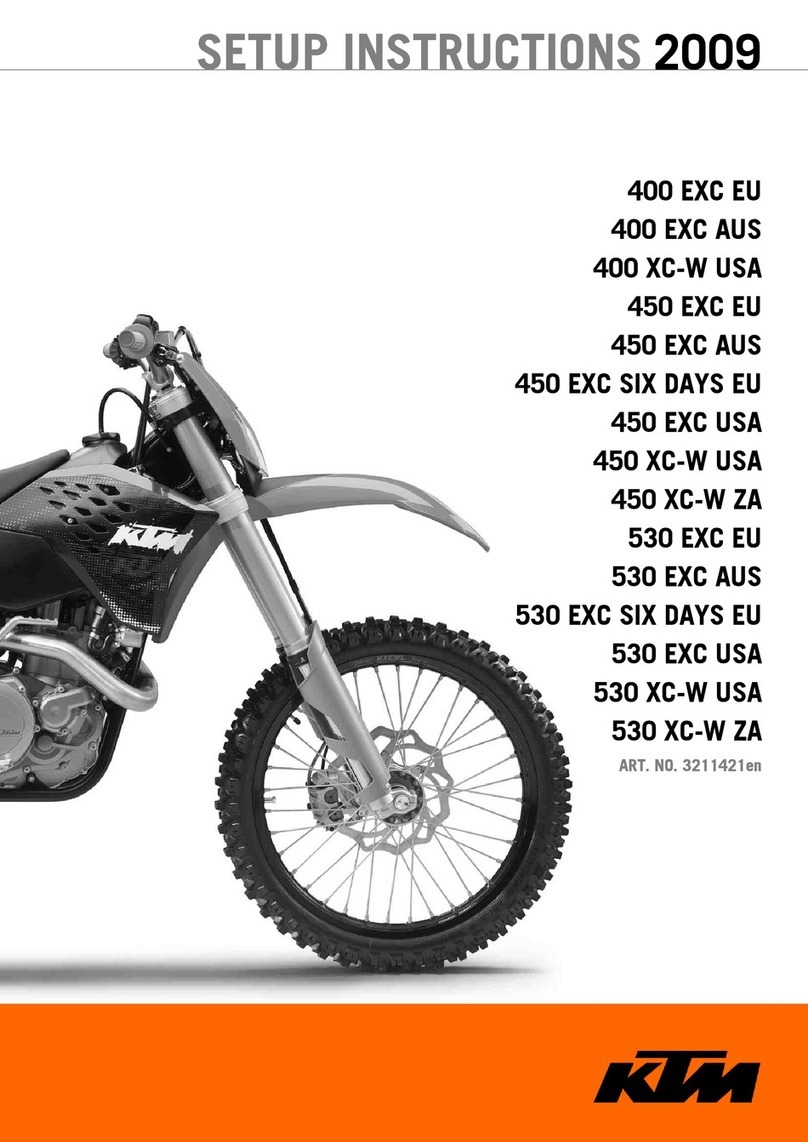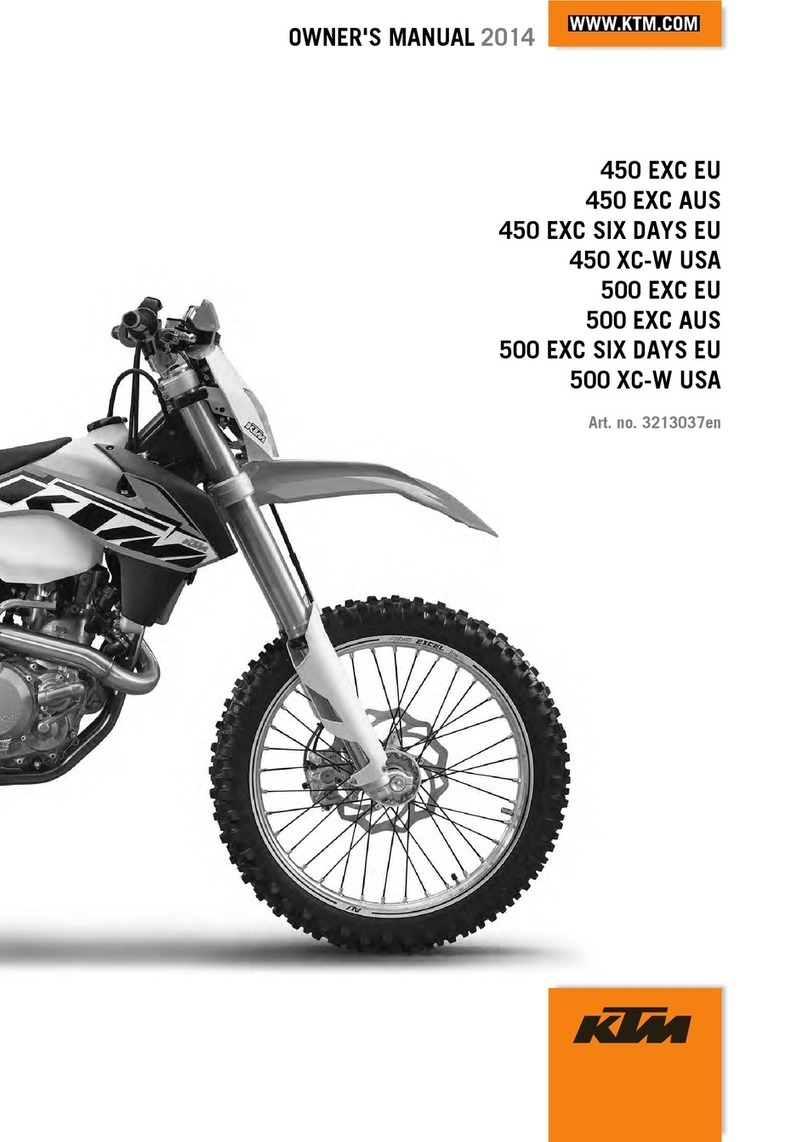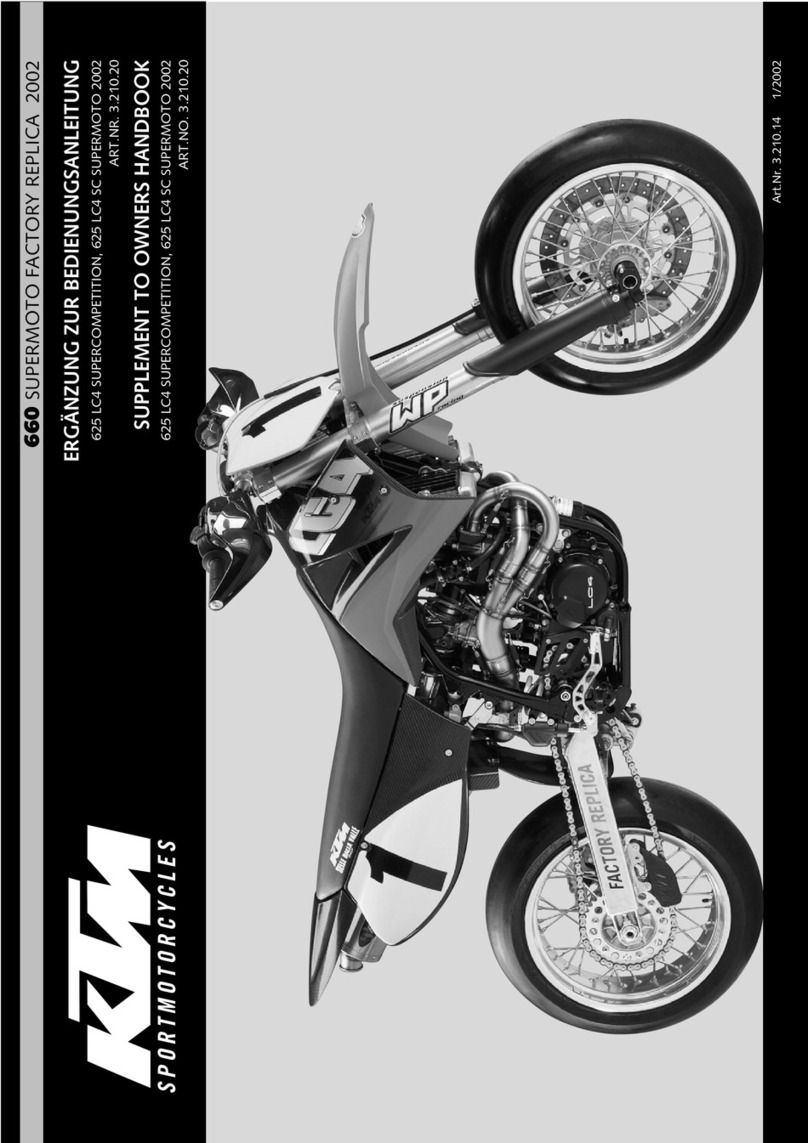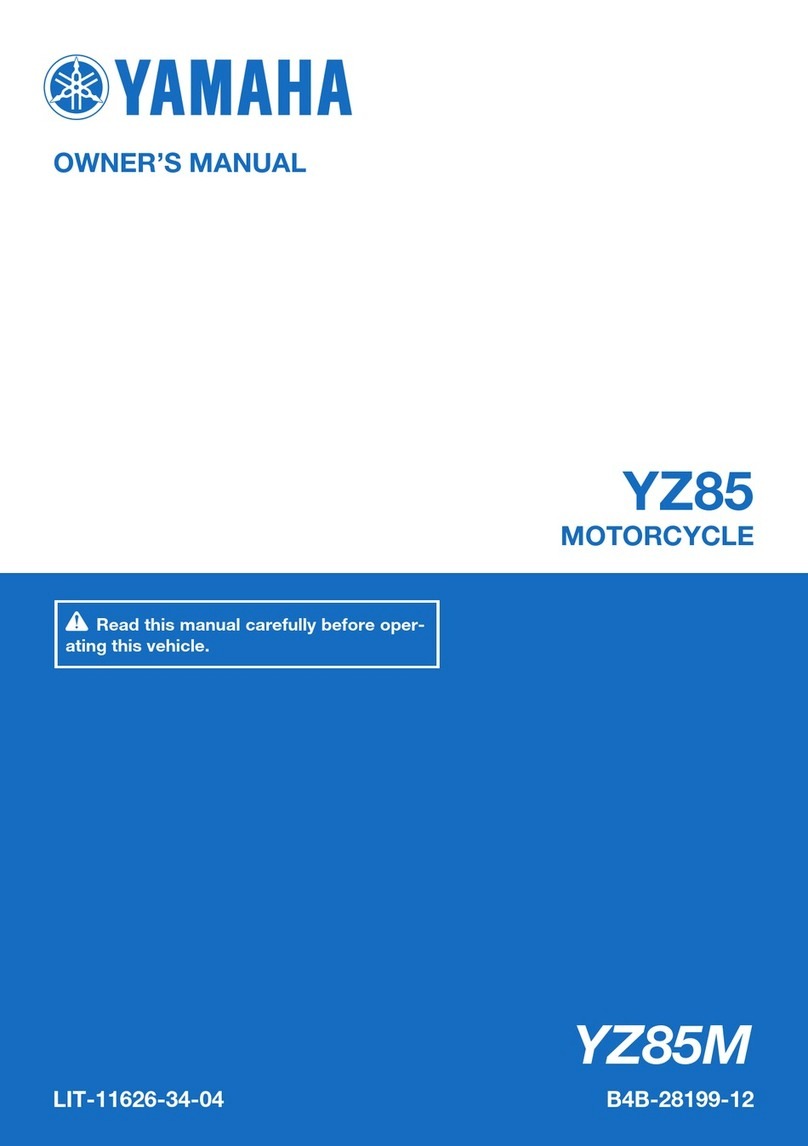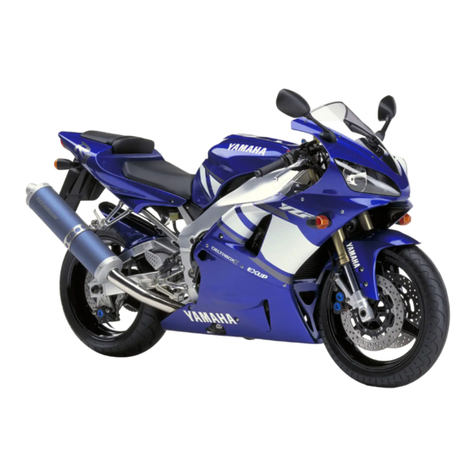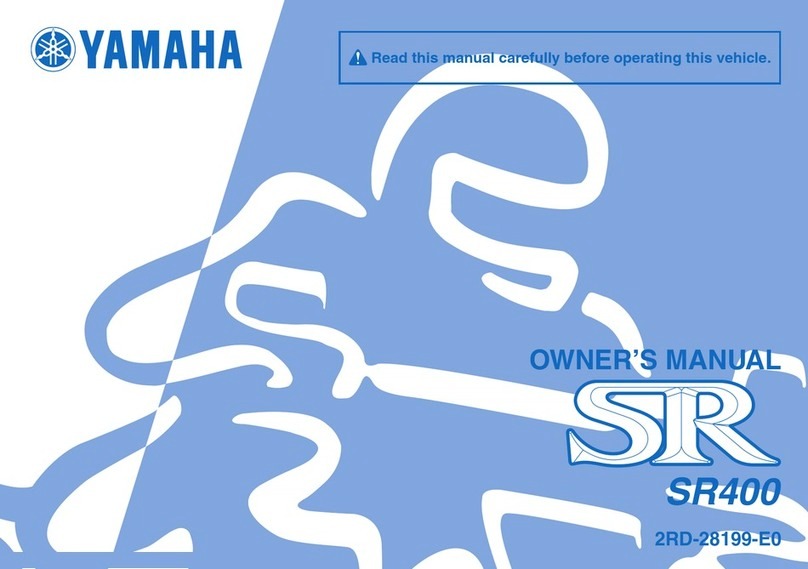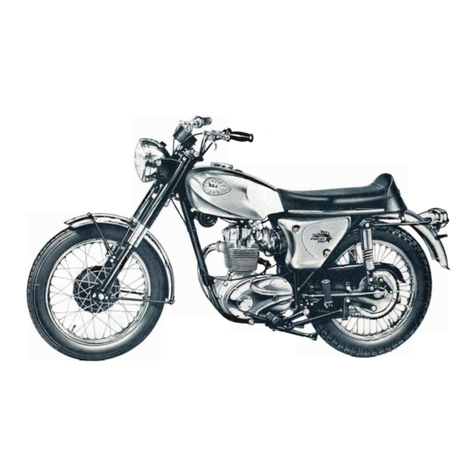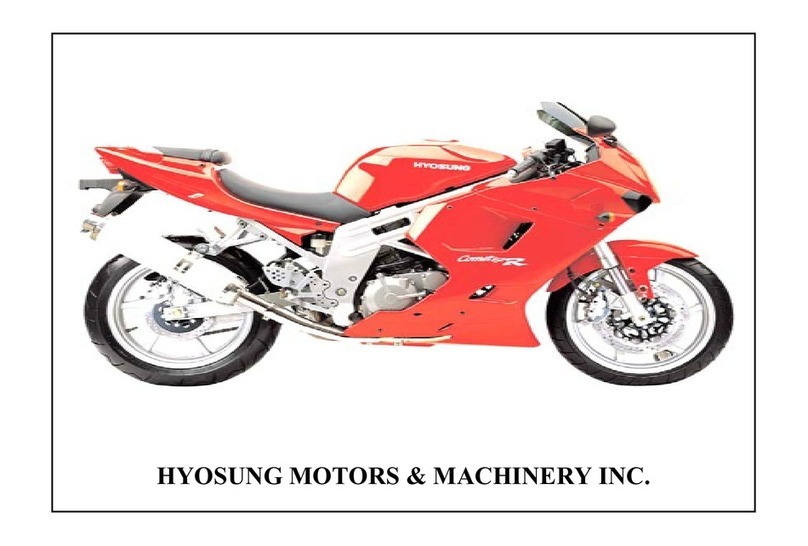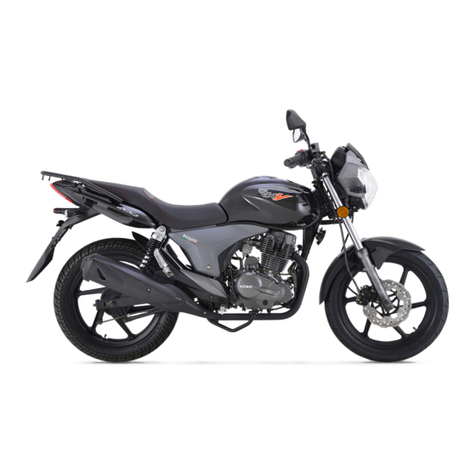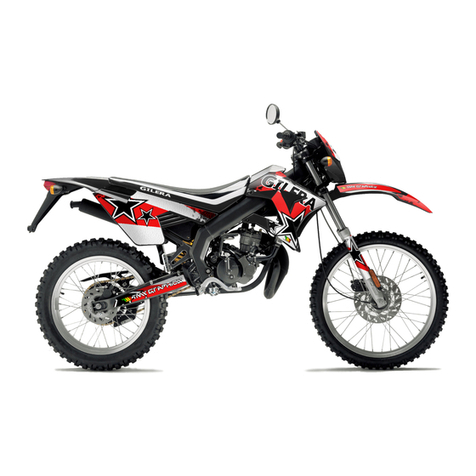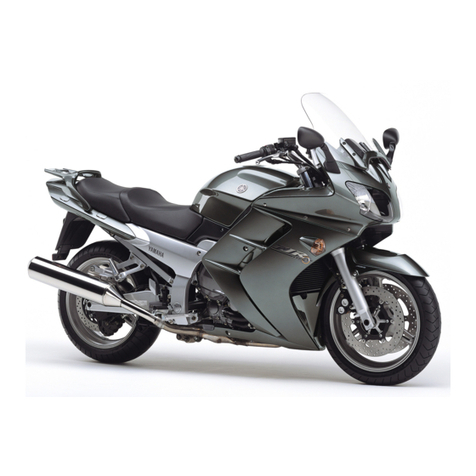Thumpstar TSE12 User manual

THUMPSTAR BALANCE BIKES
PLEASE READ MANUAL CAREFULLY BEFORE OPERATING
We care about the safety and comfort of our customers. This manual will guide you through proper
techniques in operating your THUMPSTAR balance bike.
For any additional information, please visit:
www.ThumpstarBalanceBike.com
THUMPSTAR electric balance bike models TSE12 and TSE16.
Read the entire manual before allowing a child to use this product.
NOTE: Manual illustrations are for demonstration purposes only. Illustrations may not reflect the exact
appearance of the actual product. Specifications are subject to change without notice. Please have your
product Serial Number (S/N) and a copy of your receipt before contacting us for warranty assistance
and/or replacement parts.
WARNING: Riding a TSE BALANCE BIKE does present potential risks and caution is required. Like any riding
product, a TSE BALANCE BIKE has inherent hazards associated with its use (for example, falling off or riding it
into a hazardous situation). When riding the TSE BALANCE BIKE, it is possible to lose control or otherwise get
into dangerous situations. Both children and the adults responsible for supervising them, must recognize that
if such hazards occur, a rider can be seriously injured or die even when using safety equipment and other
precautions. RIDE AT YOUR OWN RISK.
IMPORTANT INFORMATION
This manual has very detailed and important information on how to operate your electric balance bike.
PLEASE TAKE A FEW MOMENTS AND READ IT CAREFULLY BEFORE OPERATING THE BIKE.
1

Front Wheel Installation
Install the front axle in the order shown above.
(Note: the 16in requires 2 washers outside; not shown)
2

Handlebar assembly
This manual covers both 12 and 16in bikes.
Read and understand this entire manual before allowing a child to use this product.
NOTE: Manual Illustrations are for demonstration purposes only. Illustrations may not reflect the exact
appearance of the actual product. Specifications are subject to change without notice.
WARNING: ADULT SUPERVISION NECESSARY
This manual contains important safety information, it is your responsibility to review this information and
make sure all riders understand warnings, cautions, instructions and safety topics. Assure that young riders
are able to safely, and responsibly, use this product. THUMPSTAR recommends that you periodically review
and reinforce the information in this manual with younger riders, and inspect and maintain the bike to
ensure their safety. If you delegate this task to another adult, it is YOUR RESPONSIBILITY to pass this owner’s
manual and all relevant information to whomever will take on this role, and ensure without question that the
rider is supervised, controlled and taught in a safe manner.
WARNING: Riding a Thumpstar Electric Balance bike DOES present potential risks and caution is
required. Like any riding product, a Thumpstar bike has inherent hazards associated with its use (for
example, falling off or riding into a hazardous situation). The bikes can and are intended to move,
therefore it is possible to lose control or otherwise get into dangerous situations. Both children and the
adults responsible for supervising them, must recognize that if such hazards occur, a rider can be
seriously injured.
RIDE AT YOUR OWN RISK
WARNING: THESE MODELS ARE NOT SUITABLE FOR CHILDREN UNDER AGE 2 OR HEAVIER THAN 120 LB
(APPROX. 60KG). No children should ride any THUMPSTAR BIKE if they cannot sit on the seat and touch both
feet flat on the ground at the same time. Because products, like THUMPSTAR BIKES, can and do present
potential hazards associated with their use. PARENTS / ADULTS ARE RESPONSIBLE FOR SELECTING RIDING
PRODUCTS THAT ARE APPROPRIATE FOR THE AGE, SIZE AND DEVELOPMENT OF A CHILD.
We recommend that children under the age of 2 should not be permitted to use the THUMPSTAR BIKE.
We recommend a minimum age of 2 years old (12in) and 4 years old (16in). These are estimated ages only
and can be affected by the rider’s size, weight or skills - not every child of 2 years old will be suited to a
3

THUMPSTAR BIKE. Any rider unable to fit comfortably on the THUMPSTAR BIKE should not attempt to ride it.
The parent’s decision to allow his or her child to ride these products should be based on the child’s maturity
and ability to follow directions and instructions. THUMPSTAR emphasizes that adults are strongly advised
NOT to disregard our recommendations or permit younger children, younger than 2 years, or older, if not
deemed suitable to ride the THUMPSTAR BIKE. These products are intended for use by children who are
competent to operate these types of products. Children with any mental or physical conditions that may
make them susceptible to injury, or impair their physical dexterity or mental capabilities to recognize,
understand, and follow safety instructions should not use or be permitted to use this product if determined
inappropriate for their abilities.
ACCEPTABLE RIDING CONDITIONS AND PRACTICES:
●Always check and obey local laws and regulations, which may affect the locations where the
THUMPSTAR BIKE may be used.
●Keep a safe distance from cars and motor vehicle traffic at all times. Never ride your THUMPSTAR
BIKE on public streets, roads, highways, at night or when visibility is limited.
●Do not twist the throttle on the handgrip unless you are sitting on the THUMPSTAR BIKE and in a
safe environment, suitable for riding.
●Avoid excessive speeds that can be associated with downhill rides.
●Maintain a grip on the handlebars with both hands at all times.
●Do not touch the brake disc or hub motor on your THUMPSTAR BIKE when in use or immediately
after riding, as these parts can become very hot after riding.
●Ride defensively. Watch out for potential obstacles that could catch your wheel or force you to
swerve suddenly or lose control.
●Be careful to avoid pedestrians, skaters, skateboarders, scooters, bikes, children or animals that
may enter your path, and respect the rights and property of others.
●These THUMPSTAR BIKES are intended for use on flat, dry surfaces, without loose debris, such as
sand, leaves, rocks or gravel. Wet, slick, bumpy, uneven or rough surfaces may impair traction
and contribute to possible accidents. Do not ride your THUMPSTAR BIKE through mud, over ice,
through puddles, in wet or icy weather, and never immerse the bike in water, as the electrical
components and drive components could be damaged by water or create other possibly unsafe
conditions.
●Never use near steps or swimming pools. Avoid sharp bumps, drainage grates, and sudden
surface changes.
●Do not attempt to or do tricks and stunts on your THUMPSTAR BIKE. These E-BALANCE BIKES are
not made to withstand abuse from misuse, such as jumping, curb grinding, or any other type of
stunts. Racing, stunt riding or other maneuvers also enhance the risk of loss of control, or may
cause uncontrolled rider actions or reactions.
●Never allow more than one person at a time to ride the bike.
●Do not ride at night or when visibility is limited.
●Never risk damaging surfaces such as carpet or flooring, by use of a THUMPSTAR BIKE indoors.
●Never tow anything or anyone with or allow your THUMPSTAR BIKE to be towed by any other
person or vehicle, motorized or not.
4

POWERED AND ROTATING PARTS WARNING:
Do not allow hands, feet, hair, any body parts, clothing, or similar articles to contact with any rotating or
moving parts, such as wheels, or drive train components. IF YOUR CHILD HAS LONG HAIR, PLEASE TUCK IT IN
THEIR SHIRT OR SECURE IT OUT OF THE WAY OF THE WHEELS.
PROPER RIDING ATTIRE:
●Always wear proper protective equipment, such as an approved and properly fitted safety helmet
(with chin strap securely buckled), eye protection, athletic shoes (lace-up shoes with rubber soles),
elbow pads and knee pads.
●Keep shoelaces tied and out of the way of the wheels, motor and drive system.
●Never ride barefoot or in sandals.
●Long-sleeved shirt, long pants, and gloves are recommended.
OPERATING AND RIDING THE BALANCE BIKE
Please familiarize yourself with the components below.
1. Frame 10. Front axle 19. Brake disc
2. Handlebar 11. Charge port
3. Handlebar grip 12. Foot rest
4. Brake lever 13. Seat
5. Throttle 14. Seat post
6. Front fork 15. Seat clamp
7. Stem 16. Hub motor
8. Head clamp 17. Rear axle nuts
9. Front wheel 18. Brake caliper
5

20. Battery
21. Controller box cover screw
22. Controller
IMPORTANT INFORMATION
Non-powered training: We recommend that you teach your child how to balance the bike first before you
add power. They should be proficient at kicking and balancing the bike before turning the power switch on.
There are many videos on YouTube which can teach them to kick and balance a bike.
6

Power Mode:
The 12in bike comes in the lowest settings and ½ power. We programmed the beginner mode so that the
bike does not move too fast and you can briskly walk next to your child while training. The throttle is not very
responsive and has a delay built in and takes a few seconds to start moving. Once they kick or you push
them, it will start to move and will slowly gain speed as it goes. This is a safety feature built in so that the bike
does not start too fast. This feature changes when you go to faster modes.
We leave the speed cap off so that you can adjust the speeds. After you have chosen a safe setting for your
child’s skill level, we recommend you cover the switch (cover is in the tool bag) so they cannot change the
mode and go faster.
The illustrations below show you the different positions of the speed switch located on the bottom of the
bike. As mentioned above, the 12in comes with 50 % power, 50% torque, kick-start and the slowest speed
setting. To change to 100 %power, full torque, non-kick mode - please refer to the next page. WARNING: it is
recommended that once you change to full-power mode, you monitor your child and make sure that they
can operate the bike safely. We recommend that you change 1 mode at a time. Do not add full power, full
torque and non-kick all at the same time. The first change you should make is to remove the kick-start mode.
After they get comfortable with the twist and go, you can change to full power mode. We suggest you
change the speed switch to the slowest position to make sure that your child can handle the speed change. In
full power mode and the highest speed setting, the twist throttle delay time is reduced to 1.5 seconds and
engages quicker, so make sure your child has enough open space in front of them to safely ride and will not
crash into any obstacles.
16in bike comes with 50% power, non-kick mode and the slowest speed setting. Follow the same instructions
as above for the 12in. See the next page for instructions on how to release the full potential of the bike.
HOW TO CHANGE THE MODES OF THE BIKE
1. Remove the screw for the plastic cover located at the bottom of the bike position. You have to
remove the silicone that covers the screw head. The cover opens from the front (round part) and
will require you to pry it open from the front area. A screwdriver or anything flat will work just fine.
WARNING: DO NOT PRY THE COVER FROM THE SIDES OR THE REAR (SEE PAGE 15), THERE ARE
LOCKING TABS ON THE REAR OF THE COVER AND YOU WILL BREAK THEM OFF. PLEASE READ THESE
INSTRUCTIONS CAREFULLY. THE COVER HAS SILICONE ON IT TO SEAL IT FROM WATER. PRY WITH
CARE.
2. Please pay attention when you remove the cover, the speed switch is connected to the cover. Once
you pry the cover off, you can move it off to the side or unplug it.
7

3. 50% power mode: Locate the solid BLACK AND WHITE wires with a black connector and unplug it.
This will give you 100% power. We put the mode wires on the top and so you can easily find them
(see pic below), 12in and 16in bike.
4. Torque reduction: Locate the solid BLACK AND YELLOW/GREEN STRIPED wire with the white
connector and unplug it. This will give you full torque. We only connect this for the 12in bike, the
16in bike has full torque.
5. NON-Kick mode: Locate the solid BLACK AND LIGHT BLUE wires with the red connector and unplug
it. This will change the bike to NON-Kick mode. 12in only. 16in has this function, however, we do
not connect it. If you want this function on your 16in bike, then connect the red connector
together.
To easier locate the wires we wrapped the wires with a white tube and zip-tied the group together. The
words ‘Zero Start Switch’, ‘Torque Switch’ and ‘Speed Limit Switch’ are on each set of the wires.
See wiring diagram below for reference.
CAUTION: Running with full speed and torque will decrease the running time and drain the battery faster.
Operating at full speed and torque for a long time, (over 5 minutes), will make the battery, controller and
motor get hot. Excessive riding in this mode will decrease the life of the components.
SAFELY APPROACHING OR RE-MOUNTING THE THUMPSTAR BIKE:
Teach children to approach the bike with caution; before use or while standing back up if knocked over.
1. Ensure the power switch is turned off.
2. Ensure all wheels/tires have stopped rotating or moving.
3. Inspect for any obvious damage.
4. Perform a Pre-Ride Inspection (below)
5. Have rider mount the THUMPSTAR BIKE, gripping the handlebars with both hands and sitting on
the seat with both feet on the ground.
6. Please press the power switch to the ‘ON’ position.
7. Carefully resume riding your bike.
LOADING AND UNLOADING THUMPSTAR BIKE INTO VEHICLE
1. Ensure the power switch is turned off.
2. Load into a vehicle for transport.
3. After unloading, ensure that Power Switch is still switched off.
4. Perform Pre-Ride Inspection.
8

CHECK AND MAINTAIN
Before use, check that the THUMPSTAR BIKE is in proper working order. The bike should be maintained and
repaired in accordance with the manufacturer’s specifications, using only the manufacturers authorized
replacement parts, and should not be modified from the manufacturer’s original design and configuration.
PRE-RIDE INSPECTION AND CHECKLIST
Power Switch: Ensure that the Power Switch is turned off during the Pre-Ride Inspection and remains ‘OFF’
until the rider is sitting on the saddle, both hands gripping the handle bars, both feet flat on the ground.
Throttle: Ensure the Power Switch is turned off. Check that the throttle rotates freely and the return spring
returns the throttle back to ‘ZERO’ position from the ‘FULL’. Ensure there are no cracks or visible damage.
Brake: Check brake for proper function. When you squeeze the lever, the brake should provide positive
braking action. Slight rubbing is normal.
Tires: Inspect tires for excess wear and aging. Regularly check the pressure and inflate as per tire specs.
Frame, fork, stem and handlebars: Check for cracks and loose hardware. Broken components are rare,
however, it is possible to break parts after you have crashed. It is important to make a regular habit of
inspecting your bike every time you ride it.
Hardware/Loose Parts: Check all your hardware such as nuts, bolts, cables, fasteners, etc, to ensure that
they are secure. There should not be any unusual rattles or sounds from loose parts or broken components.
If the unit is damaged, do not ride it. Reference ‘Warnings’ listed in this manual.
Laws and Regulations: Check and obey local laws or regulations prior to riding.
Adjust the height of the seat.
9

After riding:
1. Check the battery capacity with the power on.
2. It is recommended to charge the battery when the red light comes on. If the balance bike
does not seem to have power, plug it in and let it charge, this could be from the rider
using the bike past the red light warning, however, it does shorten the battery life cycle.
3. If the yellow light is on… keep going. If they are done riding and the yellow light is on,
charge it.
4. Charging after each use is a good idea.
Charging:
1. Insert the charger into 110V/220V wall socket; the light on the charger will turn green.
2. Insert the plug from the charger into the charger port on the frame of the bike (you might see a
small spark or hear a pop, this is normal).
3. The light on the charger will turn RED, indicating that the battery is being charged. If the light does
not turn RED then the battery is fully charged or has a problem. Please see the ‘Troubleshooting’
section for further instructions or contact your dealer.
4. The light will turn GREEN indicating that the battery is fully charged.
5. Make sure that the bike is charged under a dry and cool surrounding.
Approx. Charging Times:
5.2Ah… 2-2.5 hours, if completely drained
Caution: Leaving the bike in direct sunlight for a long time (5-8 hours) will harm the battery or even cause
it to explode.
REPAIR AND MAINTENANCE:
Tools include in the kit:
●2.5, 4, 5, 6 and 8 mm Allen Wrench
●14,16,19 mm socket or open spanner
Turn power switch to “OFF” position, allow THUMPSTAR BIKE to be cool before beginning repair or
maintenance:
●Read instructions.
●Ensure the power switch to the “OFF”.
●Ensure THUMPSTAR BIKE has had adequate time to cool (up to 30 minutes)
●Secure the THUMPSTAR BIKE for repair or maintenance.
●Exercise caution around exposed parts.
●Contact THUMPSTAR customer service if unsure about any repair or maintenance.
Replacement parts:
For the complete selection of replacement parts visit www.THUMPSTARBALANCEBIKE.COM
Repair Centers:
For a list of authorized THUMPSTAR service centers, check Online at:
www.ThumpstarBalanceBike.com
10

Test Brake:
1. Squeeze brake and hold.
2. Push the bike forward. The rear wheel should not spin if the brake is adjusted properly.
3. If rear wheel spins when pushing forward or bike lever engages prematurely, refer to “adjust
Brake”
Adjust Brake:
1. To adjust brake cable:
a) Twist brake lever adjust in or out, ¼ to ½ turn at a time, until desired brake adjustment is
attained.
b) If brake still needs further adjustment, proceed to step 2.
2. Determine if brake cable loose or brake rotor is dragged on brake pad or not:
a) Loosen brake hubs barrel adjuster.
b) Adjust brake hub adjuster in or out until the desired brake adjustment is attained.
c) Lock brake hub barrel adjuster.
d) Perform final adjustment of tension in brake cable with brake lever barrel adjuster.
e) Repeat “Test Brake” section above
WARNING: Test and practice breaking in an open area free from obstacles, in a straight line, until the child is
familiar with the brake function.
Battery Removal and Installation
Step one: Use a Phillips screwdriver (provided in the tool kit) and remove the screw at the bottom of the
large round tube (position 21. Fist pic below). Get a flat head screwdriver or anything that is flat, and pry the
front of the cover up near the area of the screw hole as shown below, pulling it up towards you. CAUTION!!
The switch is connected to the cover; pull with care. Unplug the switch. Do not pry the side or rear of the
cover (see pic below), you could break the locking tabs off.
11

Step two: After you have removed the cover, take some pictures. Carefully pull out the wires of the
controllers and only unplug the three pin throttle wires (org,green,blk), 2 pin power switch (pink and blk), 2
pin Brake switch (blue,blk), yellow XR60 connector for battery. Do not disconnect the large black round plug
or the wires that are zip tied together. Pull out the controllers and let it hang off to the side (pic below). If
you accidentally unplugged the large round black connector, make sure you line up the arrows when you
plug it back together.
Step three: Remove the small screws of the changing port near the top of the tube. Carefully pull the
charging point out and unplug the red connector..
Step four: Push the wires, string and charging port back into the hole. Do NOT plug it back together.
12

Step five: Find the cloth strap inside the controller box that is attached to the battery (see pic). Slowly pull on
the cloth strap, you might have to pull a bit hard, and slide the battery out. When the battery is almost out
use caution because the battery charge wires are connected to the charging port with the string attached to
it. Once the battery is out, set it on the side of the tire and frame so you can untie the string (see pic).
BATTERY INSTALLATION
Install the battery in reverse order. Below are instructions just in case you forgot.
Step one: Lay the battery on the side of the tire and frame with the yellow connector facing the rear of the
bike and the small charging wires towards the front. Find the string you disconnected from the old battery
and tie it around one or both of the wires (see pic below).
Step two: Pull the charger port out and pull on the string, stop when tight. Pick up the battery and move it
towards the tube, pull on the string some more to make it tight, lay the charge wire into the groove on the
side of the battery that has the smoother groove, find the smaller black wires (this protects the charger wires
from getting cut as you slide the battery into the tube), find the thicker wire (throttle wire and power switch)
and lay it into the other side groove, pull both sides of wires up to the halfway point and hold the wires with
one hand as you put the battery into the tube slowly, as you are pushing the wires into the tube you need to
pull on the string and other 2 wires that are on the opposite side (do not pull the too hard). Once the battery
13

is halfway in, pull on the throttle wire and brake wire so the connectors are about 30-40mm past the battery
(see pic). Repeat this step with the brake switch wire but this time hold the string so you do not pull on the
charger wire as well (see pic below)
Step three: Hold the top of the battery and pinch the wires with your thumb and fingers to stop the wires
from sliding up and out as you push the battery in until you have reached the 90% point, lightly tug on the
string and pull the charging wires out of the hole (DO NOT YANK THE CHARGE WIRE, WIGGLE AND PULL. DO
NOT USE A METAL OBJECT TO PULL THE WIRES OUT OF THE HOLE), go to the other side and pull the slack out
of the wires.
After you have removed the slack out of the wire, and pulled the charge wire out of the hole, you can push
the battery in all the way. Put your 2 thumbs on top of the battery and push the battery inside (see pic
below). Be careful not to push the battery in too far because you will pinch the 2 sets of wires coming out of
the hole near the handle bars side (12in only) however it needs to go in far enough so the controller can fit
in.
14

Step four: Put the controller back in the box, backside first (no wires side) goes in first. If you disconnected
the motor wire plug it in first (don’t forget to align the arrows and push hard), lay the large black wire on the
right side as shown in the pic below, make sure all the wires go under the large black wire or the black wire
wraps around the outside of all the wires. They should look like the pic below. Lay the wires to the left side so
that they are not all bunched up in the center (they will push on the switch and cause damage) and the larger
wire for the motor will lie on the right side, as you are looking from the back (see pic below). Plug in the
throttle wire, power switch, and brake switch (the wires that come from the handlebars and you put it next
to the battery, see diagram on the last page for wire color reference) and tuck the connectors in the front
between the battery and controller.
We recommend you use silicone to reseal the box. Plug in the switch on the cover slide in the back first. The
locking tabs on the rear of the cover will go in first. Close the cover and push on the front tab so it slides into
the box (it will be a little tight), lightly tap on the cover to make sure it is down all the way. Insert screw.
Step five: Plug the charging port back together (make sure the wire colors are matching before you push),
push connector together with some force to ensure the plug is connected properly, stuff the wires and the
string back into the hole, install your screws and you are done. Charge the battery to make sure it is working
properly.
15

Battery Disposal: Your THUMPSTAR product uses sealed lithium 18650 cell batteries, which must be recycled
or disposed of in an environmentally-friendly manner. Do not dispose of a lithium cell battery in a fire; the
battery may explode or leak. Do not dispose of a lithium cell battery in your regular household trash. Recycle
your batteries according to federal or state law.
16

TROUBLESHOOTING GUIDE
Make sure the battery is fully charged or replaced before performing any trouble shooting ONLY to be
performed by an adult.
PROBLEM:
POSSIBLE CAUSE:
SOLUTION:
Power switch does not work
Battery not fully charged
Verify the battery is fully charged
Wire harness connection, faulty
switch, bad controller
Remove the controller box cover and
locate the solid dark blue and black
wires. Un-plug it and pluck it back in,
press the switch – same result…
Unplug the connector and connect a
volt meter (ohm function) to red and
blue wires that go to the switch and
depress the switch. You should see
the meter go to 0. No charge-switch is
bad. If the meter went to 0 then you
have a bad controller.
Bike stopped working while riding it
Loose battery or wire connection(s)
Recharge or replace battery
Power switch faulty
Contact your local THUMPSTAR
authorized service center for diagnosis
and repair
Throttle faulty
Motor or electrical system damage
Rider weight/ Terrain too steep
Do not exceed the weight limit of
120lb (65kg), ride on flat terrain
Short run time/runs slow
Battery not fully charged
Verify the battery is fully charged
Old or damaged battery
Replace battery
Tire is not properly inflated
Inflate tires to the recommended
pressure on tire sidewall. Replace tube
if you are unable to maintain pressure.
Brakes are not adjusted properly
Adjust the brakes, ensure the brakes
are not rubbing on the discs
Runs intermittently
Loose connection(s)
Check for loose connections/wires
17

For more troubleshooting tips, a list of available replacement parts, or to locate an authorized Service Center
in your area, visit our website at www.THUMPSTARBALANCEBIKE.COM
PRODUCT PARTS:
Keep your TSE BALANCE bike running for years with genuine THUMPSTAR parts. Visit
www.THUMPSTARBALANCEBIKE.COM for information on spare part availability. (Illustrations may not reflect
the exact appearance of the actual product, specifications subject to change without notice.
THUMPSTAR BIKE LIMITED WARRANTY
THUMPSTAR warranties the product to be free from material and manufacturing defects from date of
purchase as described below
●Frame – Three years
●Electrical system components, including battery and charger – 90 days.
This Limited Warranty will be void if the product is not used in accordance with the owner’s manual.
●Damage in an accident, crash or loss of control incident
●Used in a manner other than for recreation.
●Poorly or incorrectly maintained.
●Used in a manner in which this product was not specifically designed.
●Failure to follow owner’s manual instructions or warnings
●Electronics or battery exposed to water.
●Modified in any way.
●Damaged by unauthorized service or parts.
●Used for commercial purposes.
This Limited Warranty does not cover any damage, failure or loss caused by improper assembly,
maintenance, or storage.
THUMPSTAR is not liable for incidental or consequential loss or damage due directly or indirectly to the use
or misuse of this product.
For your records, save your original sales receipt with this manual and write the serial number below. Serial
number is located on the rear hub motor.
-------------------------------------------------------------------------------------------------------------------------------------------------
Serial Number (located on the hub motor): ________________________________________________
Date Purchased:________________________________________________
18

Controller diagram for reference
THUMPSTAR is not liable for incidental or consequential loss or damage due directly or indirectly to the use
or misuse of this product.
19
Other manuals for TSE12
1
This manual suits for next models
1
Table of contents
